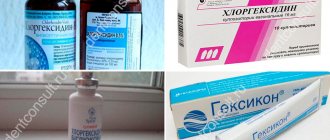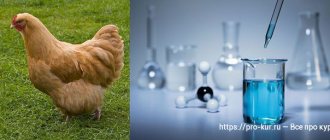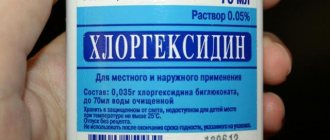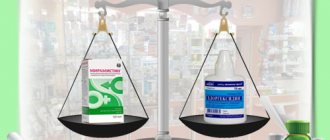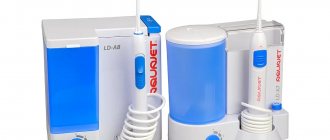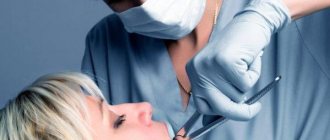Where is Chlorhexidine used?
The pharmaceutical product is used for the treatment and prevention of diseases caused by microorganisms sensitive to Chlorhexidine.
Depending on the concentration of the substance, the medicine can be used in the treatment of various pathologies.
After operations, in order to prevent infectious pathologies, doctors resort to using a pharmaceutical solution.
Chlorhexidine is often used for dental purposes for the treatment of dentures. In some cases, medication is used to treat periodontitis, stomatitis, and they are used to rinse the gums.
The medicine is used in:
- Urology
- Gynecology
- Surgery
Chlorhexidine bigluconate
Belongs to the group of halogens. Typically used in concentrations of 0.5–4.0%. At lower concentrations, the bactericidal activity of chlorhexidine decreases, therefore, as an antiseptic in this case, it is used only in an alcohol solution. Chlorhexidine has bacteriostatic, fungicidal, antiviral properties. However, 1% chlorhexidine against fungi and mycobacteria tuberculosis has a weaker effect compared to povidone-iodine. The drug can be used for the initial treatment of injured skin areas, as well as to accelerate the healing of purulent wounds and for the treatment of damaged mucous membranes. In most cases it is well tolerated. There are no age restrictions for use - a good antiseptic option for children. It is not recommended to use together with iodine preparations (often skin irritation).
Contraindications
Chlorhexidine is contraindicated:
- In case of hypersensitivity to the components of the drug
- People suffering from dermatitis
- Do not use together with other antiseptics, for example, with hydrogen peroxide
- For ophthalmic use, rinsing the eyes with this product is prohibited.
- For disinfection of the surgical field
- After intervention on the auditory canal and central nervous system
It is important to know that the pharmaceutical product should be used with caution when treating children.
Octenidine (octenidine dihydrochloride)
A cationic surfactant with antimicrobial activity against gram-positive and gram-negative bacteria, viruses, as well as against yeast-like fungi and dermatophytes (fungi that feed on keratin and cause dermatomycosis). Similar in action to quaternary ammonium compounds (QAC). The damaged surface is completely processed. Can be used on mucous membranes. The antiseptic has no age restrictions and is used for children. Currently, it is the drug of choice in Europe as an antiseptic due to its wide spectrum of action and maximum speed of achieving effect.
Table 1. Comparative characteristics of the main antiseptic agents
| Antiseptic | For leather processing | For treating wounds | For mucous membranes | Applicability for children |
| Ethanol | + | _ | _ | — |
| Hydrogen peroxide | + | + | + | + |
| Iodine | + | _ | — / + | — / + |
| Chlorhexidine | + | + | + | + |
| Potassium permanganate | + | _ | _ | + |
| Diamond green | + | _ | _ | + |
| Fukortsin | + | _ | _ | _ |
| Benzyldimethylmyristoylaminopropylammonium | + | + | + | + |
| Octenidine | + | + | + | + |
Brief instructions for use
To prevent sexually transmitted diseases, after unprotected sexual intercourse, after a maximum of 2 hours, 2-3 ml of a 0.5% solution should be administered into the urinary canal of a man, 1 ml into the canal for women and 5-10 ml into the vagina. You can treat skin areas near the genitals with the product. After administering the drug, try to postpone urination for 2 hours.
Your doctor should tell you about douching for gynecological diseases.
For sore throat, rinse the mouth with 0.5% or 0.2% Chlorohexidine solution.
For inflammatory pathologies of the urinary tract, it is necessary to inject 2-3 ml of 0.05% of the product into the urinary canal.
Before using the drug, you should consult your doctor.
Application area
The main area of application of chlorhexidine bigluconate is medicine. In various forms it is used to treat runny nose, pharyngitis, laryngitis, stomatitis. This is an effective drug for the prevention of sexually transmitted diseases.
Chlorhexidine can be used both for the treatment and prevention of numerous diseases. But here it is important to choose the right concentration. For example, solutions containing a substance of 0.05─0.5% are used for applications and rinses. Gels with a concentration of 0.5% are used for external and local use. To rinse the mouth, use an aqueous solution with a concentration of 0.2% or an alcohol solution with a concentration of 0.1%.
The use of the drug for hand disinfection is popular; it is an excellent antiseptic: at the height of the coronavirus epidemic, its use has increased significantly.
The substance is used in surgery to treat the hands of medical personnel; it is also used to sterilize instruments; for this purpose, a half-percent alcohol solution or one-percent aqueous solution is used. The injection sites are treated with the product.
Due to its effective disinfecting effect, the places where bigluconate-based antiseptics are used are:
- Children's institutions: kindergartens, schools, colleges, etc.
- Communal facilities: baths, swimming pools, public toilets, etc.
- Sports facilities: gyms, fitness centers, etc.
- Beauty salons: hairdressers, beauty salons.
- Places of recreation and entertainment: nightclubs, cinemas, museums, theaters.
- Catering: canteens, bars, restaurants.
In addition, antiseptics are actively used in resorts, sanatoriums, cultural and health complexes, social security institutions and in everyday life.
Where to put candles
Depending on the type of disease, the method of administering Chlorhexidine suppositories can be different: rectal or vaginal.
But it is important to understand that the use of suppositories is only permissible as prescribed by a doctor.
Before using the suppository, you need to wash and dry your hands well, then you need to remove it from the package and insert it into the vagina in a lying position.
To avoid leakage of the drug, do not rush to get out of bed.
Chlorhexidine suppositories help well with thrush and cystitis.
What is Chlorhexidine
Chlorhexidine has bactericidal, fungicidal and virucidal properties. It is most often used as an antibacterial, antiseptic and disinfectant. Antiseptic drugs are also prepared with Chlogexidine. Due to its wide spectrum of action on bacteria, fungi, viruses and mild irritating effects on the mucous membrane and skin, the drug is widely used in medicine:
- its effect is reduced or neutralized in the presence of organic alkaline substances, in particular soap;
- in bacterial cells, Chlorhexidine damages the membrane, which leads to the death of pathogens;
- Chlorhexidine is highly soluble in organic solvents such as dichloromethane.
Chlorhexidine was initially used in veterinary medicine and was also tested as a cure for malaria. Later it began to be successfully used to combat bacteria.
Why is Chlorhexidine better than peroxide?
- Hydrogen peroxide and Chlorhexidine are antiseptics. Medicines differ in their spectrum of effects and medicinal properties.
- Hydrogen peroxide, unlike Chlorhexidine, is available in only one dosage form, which is not very convenient.
Chlorkesidine suppositories are used for the treatment of gynecological and urological pathologies.
Both products disinfect wounds and abrasions well.
Chlorhexidine has a wider range of therapeutic effects; it is used to treat the hands of the surgeon and nurse before surgery, and it is also used in gynecology.
Hydrogen peroxide
Only a 3% solution is used to treat wounds (a higher concentration can cause a chemical burn). It is also used as a hemostatic agent. Hydrogen peroxide is an excellent remedy for primary wound treatment (washing), as it has great cleaning ability - dirt particles and damaged cells are mechanically removed with the resulting foam. You can treat wounds both on the surface of the skin and on the mucous membranes. Hydrogen peroxide is generally not used on healing wounds, as it prolongs the period of complete healing. It is also not used for deep wounds and is not injected into body cavities. When stored in light, it loses its active properties. Open packaging is stored for about a month, closed - 2 years.
Chlorhexidine in gynecology: advantages and disadvantages
The main advantages of the drug, doctors include the following:
- The composition demonstrates high activity in suppressing and inhibiting various forms and types of fungi and bacteria, protozoa and herpes.
- The therapeutic effect itself is not marked by any stage - it remains in the vagina after the injection and acts for a certain period of time.
- The drug is effective even in a purulent environment, and the drug itself is used both for injection into the human body and for processing medical instruments.
- The composition is presented on the pharmaceutical market in several forms - in the form of a gel and solution, vaginal suppositories, which will allow you to choose the best option and scheme for its use.
Moreover, the drug can be used during pregnancy, but after consultation with your doctor. As for the disadvantages of this drug, first of all it is worth noting that if used incorrectly, serious side effects are possible.
This and structural changes in the vaginal mucosa provoke chemical burns and have a strong drying effect. In addition, there is a high probability that it will not suppress pathogenic microflora, but will provoke the appearance of a bacterial form of vaginosis.
Wound treatment with Chlorhexidine
The main purpose of the drug is precisely the antiseptic treatment of various surfaces, not only healthy skin, but also wounds of almost any origin.
The product belongs to the group of special germicidal antibiotics, and therefore Chlorhexidine is capable of not only stopping the growth of harmful microorganisms, preventing their reproduction, but also completely destroying pathogenic elements.
If we compare the product with other drugs of the antiseptic group, we can note that Chlorhexidine has no color or any odor, which means that this antiseptic is not toxic, does not leave marks on the skin, and does not cause pain to the patient when treating wounds, which is also significant advantages.
The drug does not have a negative effect on the healing process and does not lead to the formation of pronounced scars.
Chlorhexidine is completely safe , it does not cause allergic reactions or irritation of damaged tissues, and therefore is very often used to treat fresh skin lesions and disinfect them, along with regular hydrogen peroxide.
To treat fresh scratches, abrasions, various wounds, including postoperative wounds, in order to prevent the development of infection, a solution of the drug is used in a concentration of 0.05 - 0.1%. A solution of the same concentration can also be used to treat burns, as well as wounds in the oral cavity after tooth extraction.
A one-time treatment of the wound immediately after receiving it does not exclude the possibility of secondary infection, therefore, after washing, a sterile bandage should be applied, and if it is small, it can be sealed with a bactericidal plaster.
To treat wounds, it is recommended to simply pour a small amount of the drug onto the surface, wait a little, and then carefully blot the residue with a sterile napkin. Before carrying out such treatment, it is recommended to thoroughly wash the wound and the skin around it with water and laundry soap to remove any existing contaminants.
The drug in a concentration of 0.1 - 0.2% is often used for disinfection when performing various medical procedures , for example, when removing splinters, opening calluses and small abscesses, boils, when striking wounds that have dried to the surface of bandages, bandages, and plaster. A solution of this concentration is also used to treat the hands of medical personnel.
Indications for use
Indications for use of the drug include:
- Carrying out disinfection of wounds of various types, including those on mucous membranes.
- Use as part of complex therapy in the treatment of various fungal infections.
- Preventive treatments to prevent STDs.
- Treatment of oral diseases such as gingivitis, periodontitis and stomatitis.
When treating wounds, cuts, abrasions and other injuries, the solution is applied directly to the surface of the skin and injury without the use of gauze pads or cotton swabs (discs). To carry out the treatment, simply pour the composition onto the damage after preliminary cleaning.
It is important to remember that when treating skin and soft tissue injuries, bleeding should be stopped before filling the wound with Chlorhexidine, since the drug does not have a hemostatic effect.
To disinfect injured areas, a solution of concentration from 0.05 to 0.1% is used. The same solution (in the same concentration) can be used to carefully treat the surface of burns, including chemical and thermal ones. In this case, the solution will work not only as an antiseptic, but also as a means of cooling the surface, as well as washing away chemicals from the skin and the site of damage that led to the burn.
Chlorhexidine is often used for dressings instead of hydrogen peroxide. Wounds, including purulent ones, are washed with the solution, the hands of medical personnel are treated, and bandages that have dried to the wounds are watered for painless and careful removal.
